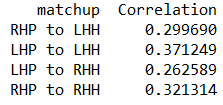I sought to generate a new means of pitch evaluation that uses exit velocity, as new research by some of the smartest people around baseball suggests that exit velocity (along with launch angle) is one of the best indicators of whether a batted ball will become a hit.
To generate this new means of measuring pitch effectiveness, I first broke the data into matchup types according to pitcher and batter handedness. Within each matchup type, I found each batter's average exit velocity against curveballs. Then, I compared the exit velocities of unique pitch events to the batter involved in the event's average exit velocity. Finally, I averaged the difference between observed and average exit velocities for each pitcher. This generates a record of each pitcher's average suppression or amplification of a batter's overall ability to hit curveballs hard.
Because this method of pitch evaluation is based on individual batters' average exit velocity, it implicitly accounts for the primary driver of exit velocity: bat speed. Additionally, because the data is split along handedness matchups, it accounts for platoon advantages.
In 2016 data, there is a direct correlation between a pitcher's mean difference between the exit velocities on curveballs he surrenders and a batter's average exit velocity on curveballs and the measured exit velocity of a unique curveball for each combination of pitcher and batter handedness. The data shows exactly what is expected: pitchers whose curveballs are, on average, hit harder than other pitchers' tend to see a higher exit velocity on specific curveballs. Put another way, if a pitcher's curveballs are all bad, it's more likely that a specific curveball he threw is bad.
The correlation between average exit velocity suppression and observed exit velocity is noticeably stronger in matchups between pitchers and batters of the same handedness:
Right handed pitchers with bad curveballs get hit even harder by right-handed batters than left-handed batters, but good curveballs against same-handed batters suppress exit velocities more than they do against opposite-handed batters.
Yovani Gallardo, recently shipped to Seattle, threw a curveball that was hit over 3 miles per hour harder by righties and 6 miles per hour harder by lefties. Dylan Bundy and Tyler Wilson throw curveballs with an apparent ability to suppress the exit velocities of left-handed hitters.
That Dylan Bundy shows up here as having a pretty good curveball is supported by Brooks Baseball's general assessment of his pitch:
His curve is a real worm killer that generates an extreme number of groundballs compared to other pitchers' curves and has a sharp downward bite.Per Fangraphs, Bundy's curveball was his most valuable pitch in 2016, with the pitch worth about 1.1 runs above average in 2016. Bundy's fastball, by comparison, was worth -4.7 runs below average. While the above analysis does not take game scenario into account, Fangraphs' pitch values do, but incorporating run expectancy based on count.
That this method of measuring pitch effectiveness is in agreement with longer-standing methods suggests that using a pitcher's mean exit velocity suppression on any pitch type can in fact give an estimation of quality of the pitch. However, this method does not take into account a pitcher's ability to induce swinging strikes, ability to throw curveballs with consistent command, game situation, or pitch sequencing. There is certainly a long way to go - for most pitch value or effectiveness measures - to incorporate all aspects of the game that affect a single pitch in a single at bat.
The top ten right-handed pitchers (minimum 5 records) by ability to suppress right-handed batters' exit velocity against curveballs are:
The top ten right-handed pitchers (minimum 5 records) by ability to suppress left-handed batters' exit velocity against curveballs are:
***
Pitcher Mean Difference from Batter Mean Exit Velocity by matchup:
Thanks to Camden Depot owner Jon Shepard for his contributions to defining the problem addressed in this article.





4 comments:
What about LH pitchers? And how do all the Oriole 40-man pitchers rank?
I wish we had talked some before you wrote this. I like the idea of what you're trying to do.
The major problem with your implementation is that you're presuming Exit Velocity is a linear metric. It's probably more like a parabola. That means that a correlation analysis has limited value for what you want to do and therefore helps explain why your results were so inconclusive.
You don't necessarily want lower Exit Velocity even if there's a correlation between that and what you do want.
Roger, I have similar charts for left-handed pitchers, but didn't put them in the article because no lefties on staff threw a pitch classified by Statcast as a curveball in 2016. I can't look at the full 40-man because, again, limited to MLB data.
Are you saying that Clayton Kershaw didn't throw any curveballs in 2016, because I am willing to bet you that you were wrong 321 times.
Post a Comment